
La-Z-Boy (LZB)
La-Z-Boy is in for a bumpy ride. Its weak sales growth and low returns on capital show it struggled to generate demand and profits.― StockStory Analyst Team
1. News
2. Summary
Why We Think La-Z-Boy Will Underperform
The prized possession of every mancave, La-Z-Boy (NYSE:LZB) is a furniture company specializing in recliners, sofas, and seats.
- 5.8% annual revenue growth over the last five years was slower than its consumer discretionary peers
- Incremental sales over the last five years were less profitable as its 4.7% annual earnings per share growth lagged its revenue gains
- Responsiveness to unforeseen market trends is restricted due to its substandard operating margin profitability


La-Z-Boy’s quality doesn’t meet our expectations. There’s a wealth of better opportunities.
Why There Are Better Opportunities Than La-Z-Boy
Why There Are Better Opportunities Than La-Z-Boy
La-Z-Boy’s stock price of $38.95 implies a valuation ratio of 14.1x forward P/E. This multiple is cheaper than most consumer discretionary peers, but we think this is justified.
It’s better to pay up for high-quality businesses with higher long-term earnings potential rather than to buy lower-quality stocks because they appear cheap. These challenged businesses often don’t re-rate, a phenomenon known as a “value trap”.
3. La-Z-Boy (LZB) Research Report: Q3 CY2025 Update
Furniture company La-Z-Boy (NYSE:LZB) announced better-than-expected revenue in Q3 CY2025, but sales were flat year on year at $522.5 million. Guidance for next quarter’s revenue was better than expected at $535 million at the midpoint, 1.1% above analysts’ estimates. Its non-GAAP profit of $0.71 per share was 31.5% above analysts’ consensus estimates.
La-Z-Boy (LZB) Q3 CY2025 Highlights:
- Revenue: $522.5 million vs analyst estimates of $516.5 million (flat year on year, 1.2% beat)
- Adjusted EPS: $0.71 vs analyst estimates of $0.54 (31.5% beat)
- Revenue Guidance for Q4 CY2025 is $535 million at the midpoint, above analyst estimates of $529.4 million
- Operating Margin: 6.9%, in line with the same quarter last year
- Free Cash Flow was $29.57 million, up from -$1.21 million in the same quarter last year
- Market Capitalization: $1.21 billion
Company Overview
The prized possession of every mancave, La-Z-Boy (NYSE:LZB) is a furniture company specializing in recliners, sofas, and seats.
La-Z-Boy revolutionized the furniture industry with the invention of the recliner in 1927. This flagship product quickly gained mainstream popularity for its comfort and functionality, and over the ensuing decades, La-Z-Boy expanded its product line to include sofas, loveseats, chairs, and living room, bedroom, and dining room sets.
Comfort is a driving force behind La-Z-Boy's design philosophy. Its furniture pieces are not just about aesthetic appeal; they incorporate ergonomic designs and smart features to enhance its products.
The company operates through a vast network of independent La-Z-Boy Furniture Galleries stores as well as partner stores. This extensive retail presence, complemented by an online platform, allows La-Z-Boy to reach a diverse customer base. La-Z-Boy also emphasizes customer service, allowing clients to personalize their designs and schedule home deliveries.
4. Home Furnishings
A healthy housing market is good for furniture demand as more consumers are buying, renting, moving, and renovating. On the other hand, periods of economic weakness or high interest rates discourage home sales and can squelch demand. In addition, home furnishing companies must contend with shifting consumer preferences such as the growing propensity to buy goods online, including big things like mattresses and sofas that were once thought to be immune from e-commerce competition.
La-Z-Boy’s primary competitors include Ethan Allen Interiors (NYSE:ETH), Bassett Furniture Industries (NASDAQ:BSET), Haverty Furniture Companies (NYSE:HVT), Flexsteel Industries (NASDAQ:FLXS), and private company Ashley Furniture.
5. Revenue Growth
Reviewing a company’s long-term sales performance reveals insights into its quality. Any business can put up a good quarter or two, but many enduring ones grow for years. Unfortunately, La-Z-Boy’s 5.8% annualized revenue growth over the last five years was sluggish. This was below our standard for the consumer discretionary sector and is a tough starting point for our analysis.
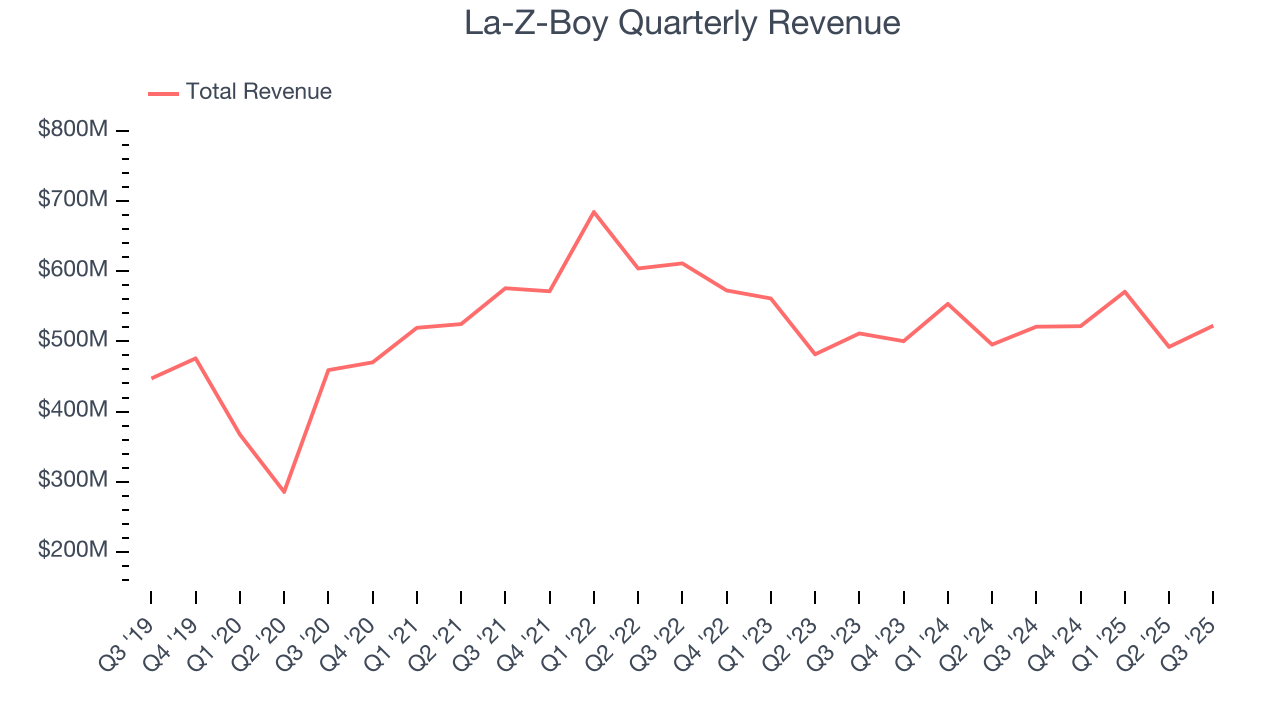
Long-term growth is the most important, but within consumer discretionary, product cycles are short and revenue can be hit-driven due to rapidly changing trends and consumer preferences. La-Z-Boy’s recent performance shows its demand has slowed as its revenue was flat over the last two years. 
We can better understand the company’s revenue dynamics by analyzing its most important segments, Wholesale and Retail, which are 62.5% and 37.5% of core revenues. Over the last two years, La-Z-Boy’s Wholesale (sales to retailers) and Retail (direct sales to consumers) revenues were flat. 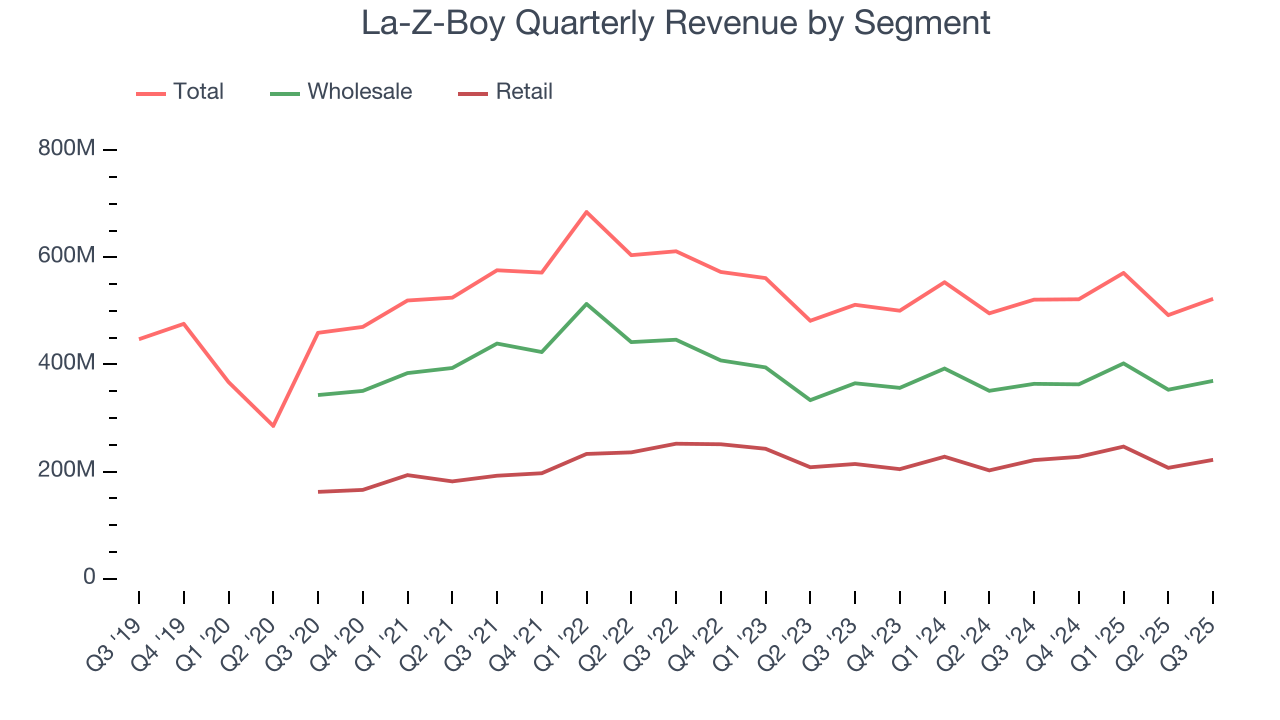
This quarter, La-Z-Boy’s $522.5 million of revenue was flat year on year but beat Wall Street’s estimates by 1.2%. Company management is currently guiding for a 2.5% year-on-year increase in sales next quarter.
Looking further ahead, sell-side analysts expect revenue to grow 3% over the next 12 months. While this projection indicates its newer products and services will fuel better top-line performance, it is still below average for the sector.
6. Operating Margin
Operating margin is an important measure of profitability as it shows the portion of revenue left after accounting for all core expenses – everything from the cost of goods sold to advertising and wages. It’s also useful for comparing profitability across companies with different levels of debt and tax rates because it excludes interest and taxes.
La-Z-Boy’s operating margin has been trending down over the last 12 months and averaged 6.6% over the last two years. The company’s profitability was mediocre for a consumer discretionary business and shows it couldn’t pass its higher operating expenses onto its customers.

In Q3, La-Z-Boy generated an operating margin profit margin of 6.9%, in line with the same quarter last year. This indicates the company’s overall cost structure has been relatively stable.
7. Earnings Per Share
Revenue trends explain a company’s historical growth, but the long-term change in earnings per share (EPS) points to the profitability of that growth – for example, a company could inflate its sales through excessive spending on advertising and promotions.
La-Z-Boy’s unimpressive 4.7% annual EPS growth over the last five years aligns with its revenue performance. This tells us it maintained its per-share profitability as it expanded.
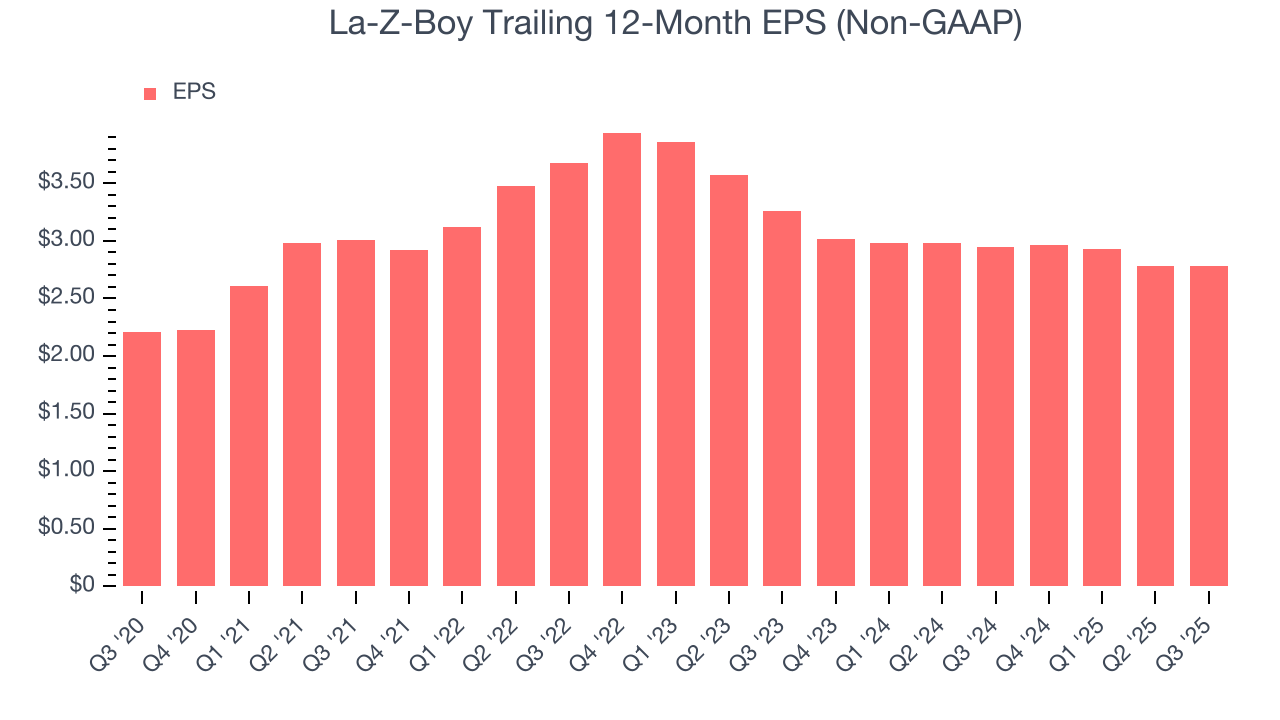
In Q3, La-Z-Boy reported adjusted EPS of $0.71, in line with the same quarter last year. This print easily cleared analysts’ estimates, and shareholders should be content with the results. Over the next 12 months, Wall Street expects La-Z-Boy’s full-year EPS of $2.78 to shrink by 4.4%.
8. Cash Is King
If you’ve followed StockStory for a while, you know we emphasize free cash flow. Why, you ask? We believe that in the end, cash is king, and you can’t use accounting profits to pay the bills.
La-Z-Boy has shown weak cash profitability over the last two years, giving the company limited opportunities to return capital to shareholders. Its free cash flow margin averaged 5.6%, subpar for a consumer discretionary business.
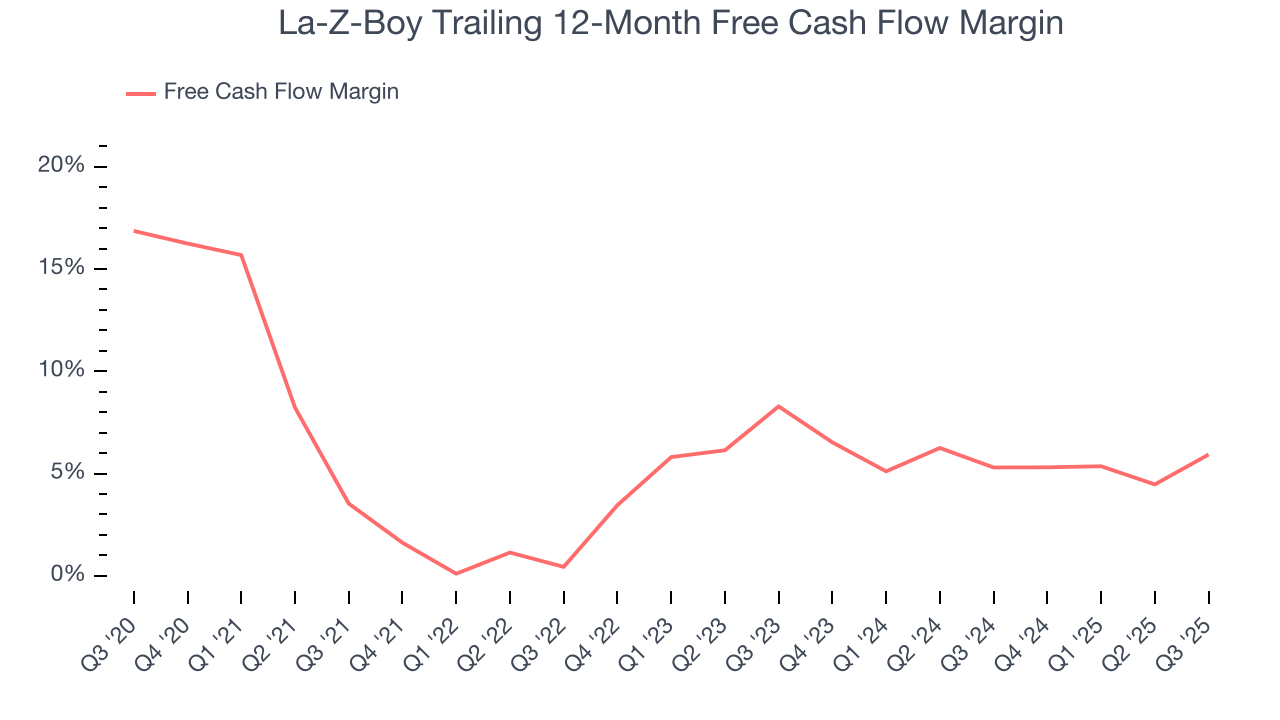
La-Z-Boy’s free cash flow clocked in at $29.57 million in Q3, equivalent to a 5.7% margin. This result was good as its margin was 5.9 percentage points higher than in the same quarter last year, but we wouldn’t put too much weight on the short term because investment needs can be seasonal, causing temporary swings. Long-term trends are more important.
Over the next year, analysts predict La-Z-Boy’s cash conversion will slightly fall. Their consensus estimates imply its free cash flow margin of 5.9% for the last 12 months will decrease to 4.7%.
9. Return on Invested Capital (ROIC)
EPS and free cash flow tell us whether a company was profitable while growing its revenue. But was it capital-efficient? Enter ROIC, a metric showing how much operating profit a company generates relative to the money it has raised (debt and equity).
La-Z-Boy’s management team makes decent investment decisions and generates value for shareholders. Its five-year average ROIC was 17%, slightly better than typical consumer discretionary business.
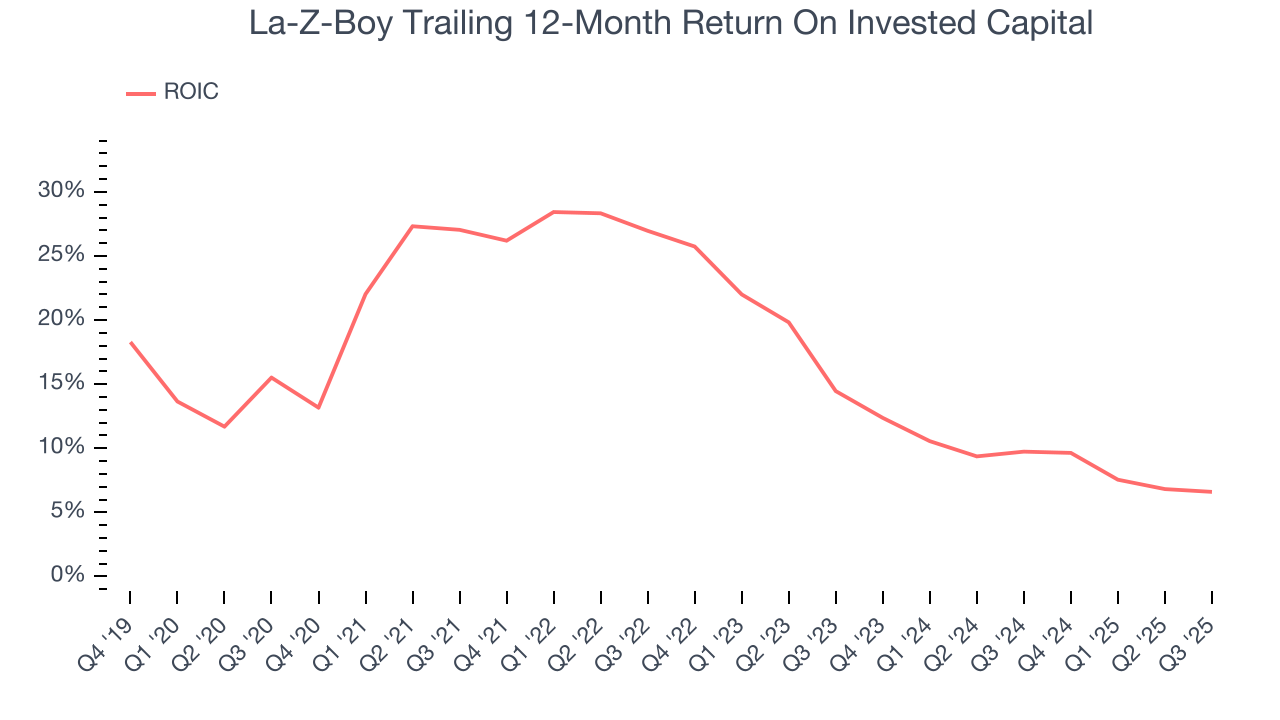
We like to invest in businesses with high returns, but the trend in a company’s ROIC is what often surprises the market and moves the stock price. Unfortunately, La-Z-Boy’s ROIC has decreased significantly over the last few years. We like what management has done in the past, but its declining returns are perhaps a symptom of fewer profitable growth opportunities.
10. Balance Sheet Assessment
La-Z-Boy reported $338.5 million of cash and $502.9 million of debt on its balance sheet in the most recent quarter. As investors in high-quality companies, we primarily focus on two things: 1) that a company’s debt level isn’t too high and 2) that its interest payments are not excessively burdening the business.
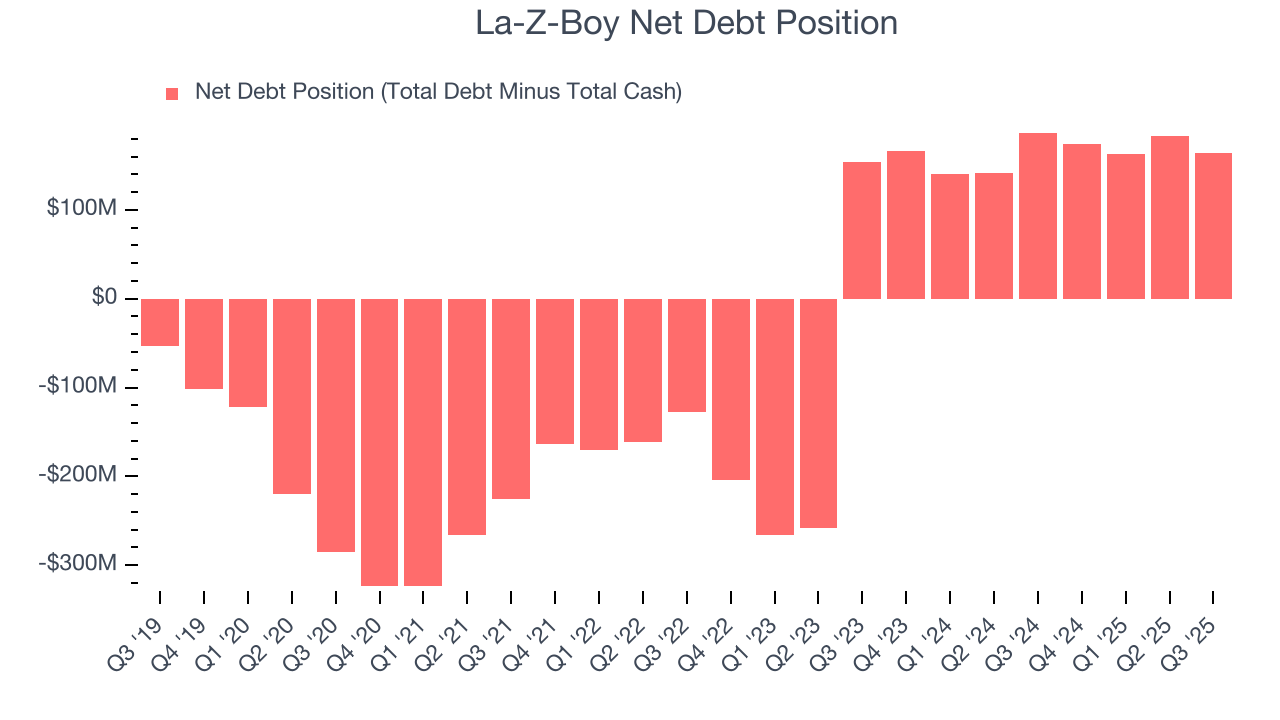
With $195.8 million of EBITDA over the last 12 months, we view La-Z-Boy’s 0.8× net-debt-to-EBITDA ratio as safe. We also see its $12.91 million of annual interest expenses as appropriate. The company’s profits give it plenty of breathing room, allowing it to continue investing in growth initiatives.
11. Key Takeaways from La-Z-Boy’s Q3 Results
It was good to see La-Z-Boy beat analysts’ EPS expectations this quarter. We were also glad its revenue guidance for next quarter slightly exceeded Wall Street’s estimates. Overall, we think this was a decent quarter with some key metrics above expectations. The stock traded up 5.7% to $31.30 immediately after reporting.
12. Is Now The Time To Buy La-Z-Boy?
Updated: December 4, 2025 at 9:53 PM EST
The latest quarterly earnings matters, sure, but we actually think longer-term fundamentals and valuation matter more. Investors should consider all these pieces before deciding whether or not to invest in La-Z-Boy.
La-Z-Boy falls short of our quality standards. First off, its revenue growth was weak over the last five years, and analysts expect its demand to deteriorate over the next 12 months. On top of that, La-Z-Boy’s Forecasted free cash flow margin for next year suggests the company will fail to improve its cash conversion, and its weak EPS growth over the last five years shows it’s failed to produce meaningful profits for shareholders.
La-Z-Boy’s P/E ratio based on the next 12 months is 14.1x. This valuation is reasonable, but the company’s shaky fundamentals present too much downside risk. There are better stocks to buy right now.
Wall Street analysts have a consensus one-year price target of $42.50 on the company (compared to the current share price of $38.95).









